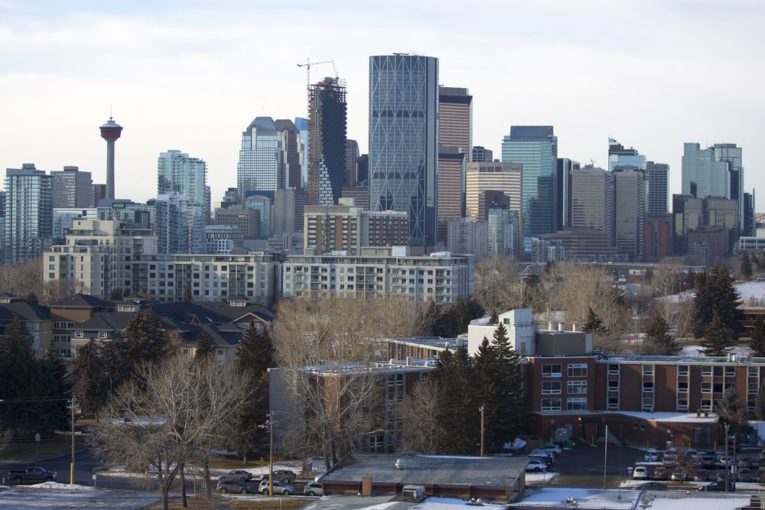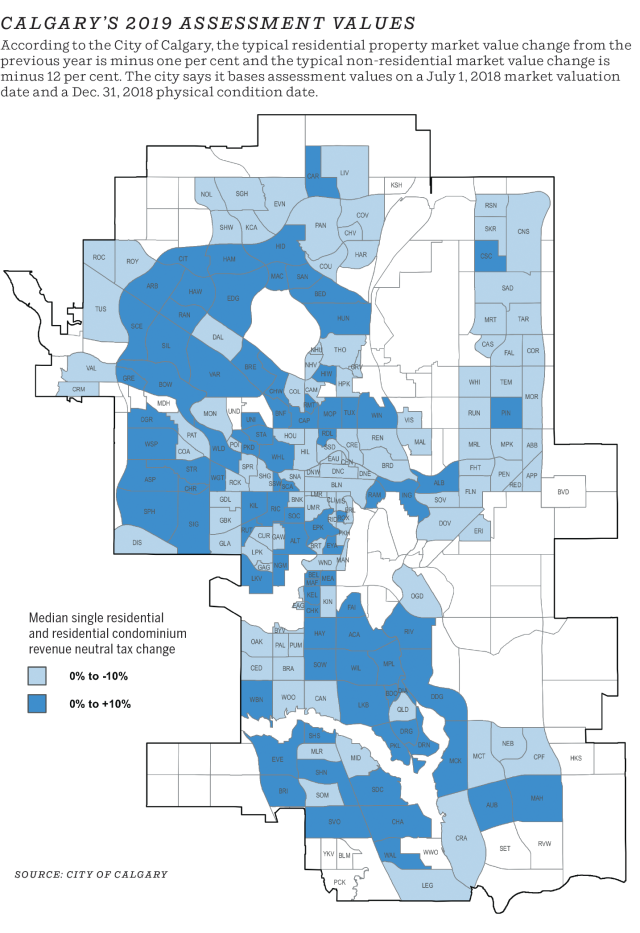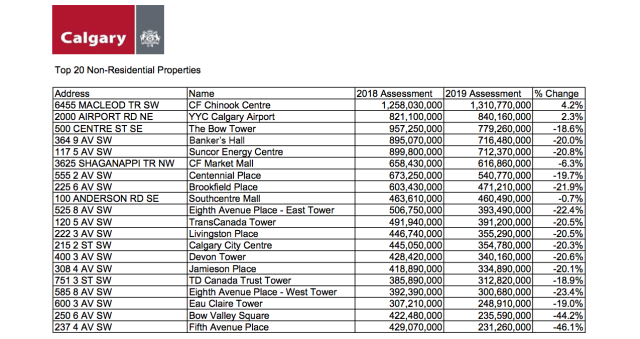
To understand the depths of the discomfort battering Calgary’s downtown in the past four years, consider a few points.
In 2015, the most valuable building in the city was The Bow, the signature crescent-shaped skyscraper on Centre Street. It commanded an assessed property value topping $1.4 billion.
By 2019, its value has fallen to $779 million, an 18.6 per cent drop in the past year alone, according to new civic data. In just four short years, its assessed property value (as of last July 1) has fallen by more than $650 million.
Poof, it’s gone, just like magic.
It’s not simply The Bow’s valuation that’s been pulverized by falling oil prices as the city’s energy-fuelled economy has decelerated.
The value of Bankers Hall is down 38 per cent during the same period, as is the Suncor Energy Centre. Both lost about 20 per cent of their value in the past year.
Scanning the downtown skyline reveals a number of the big office towers have seen their valuations similarly drop during the city’s annual property reassessment process. The decline is mainly caused by high vacancy rates, lower rents and the diminished price tag for buildings sold in the area.
“This is just one of the many things that comes with an oil-based downturn,” said Greg Kwong, regional managing director for commercial real estate firm CBRE Ltd.
“The disease we have to look at is unemployment. The symptom is lower tax revenue from the core.”
According to a CBRE report, the downtown vacancy rate decreased slightly in the fourth quarter of last year to 26.4 per cent.
But the city’s new property assessment data, released Thursday, underscores the fallout for businesses from this persistent issue.
The combined value of all office properties in the city plummeted 31 per cent in the past year, primarily because of ongoing economic challenges in the core.
“They have certainly seen a big decline. It’s a little too early to say whether we have bottomed out, but I think we are reaching that now,” city assessor Nelson Karpa said in an interview.
Under the annual property tax reassessment process, the drop in value in one area must be picked up by businesses in other places, such as the suburbs, as the city needs to generate the same amount of revenue to pay for civic services.

So what does this all mean in 2019?
If nothing else changes, 64 per cent of non-residential property owners — more than 8,000 tax accounts — will see increases of 10 per cent or more this year, simply due to the changes triggered by the revenue-neutral reassessment system.
This phenomenon is unfolding at the same time retail properties actually increased by one per cent in value for 2019, and industrial properties in Calgary dipped slightly by three per cent, the city reported.
The bustling Chinook Centre, for example, saw its value increase by about 4.2 per cent to $1.3 billion this year. Other commercial areas along 17th Avenue and in Inglewood have also seen their values rise.

The top 20 non-residential property assessments in Calgary for 2019. Courtesy the City of Calgary.
The impact of the downtown towers losing their lustre — they kept rising in value during the boom years, covering more of the overall tax load for the city — has significant ramifications for city hall and business operators.
According to city documents provided to Postmedia, 8,002 commercial properties will face double-digit tax hikes this year, due solely to the reassessment changes.
And consider this nugget for a moment: About 1,300 are slated to face a jump of 30 per cent or more, if council doesn’t take further steps to soften the blow.
Over the past two years, the city has stepped in and capped big reassessment tax increases for businesses at five per cent annually by dipping into its reserve funds.
Council has discussed doing something similar this year to limit increases to 10 per cent, although it’s still consulting with business groups such as the Calgary Chamber of Commerce.
Chamber spokesman Mark Cooper said a double-digit hike is still far too high, as many companies are struggling with the weak economic recovery and increasing costs from all levels of government.
“It’s a double whammy. We have seen vibrancy stripped from the downtown due to the rising vacancy rates because of the downturn, and now we risk losing businesses outside of the core that are being weighed down by unattainable tax increases,” he said.
Small businesses are particularly vulnerable to any tax shift, as they usually have the least amount of wiggle room to take on higher expenses.
“For some businesses, it is not going to be going up by a little, but it is going to be going up by a lot. They are going to see a huge new tax bill for 2019,” said Richard Truscott of the Canadian Federation of Independent Business.
“We are likely to see even more businesses closing their doors over the coming months.”
To their credit, council, administration and business leaders understand they have a colossal problem on their hands and are working together to search for solutions.
Related
Back in November, councillors said that while residential property owners would be expected to face a 2019 property tax increase of 3.45 per cent, commercial property owners would see a lesser 1.42 per cent hike.
That’s a start, but more needs to be done.
The city will examine other options to limit increases to businesses in the coming weeks, getting additional information from administration before the end of the first quarter.
It would be unreasonable to see almost two-thirds of businesses face a double-digit tax hike simply because of property reassessment, given the fragile state of the economy.
But the persistent problems facing the downtown aren’t going away soon, not until more jobs are created, vacant floors start to fill up and values begin to rise inside those shiny — and frequently empty — Calgary office towers.
Chris Varcoe is a Calgary Herald columnist.
You can read more of the news on source
